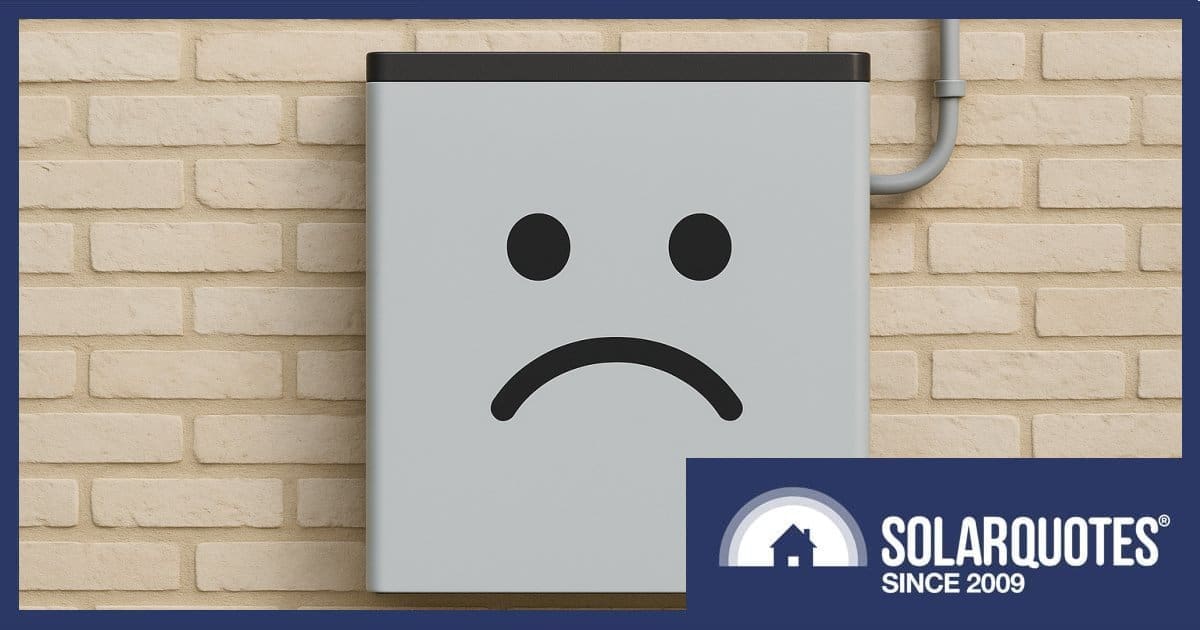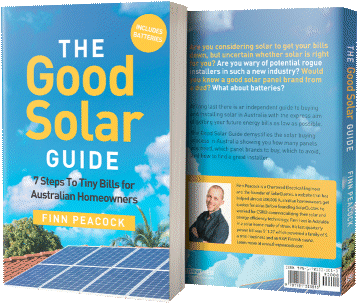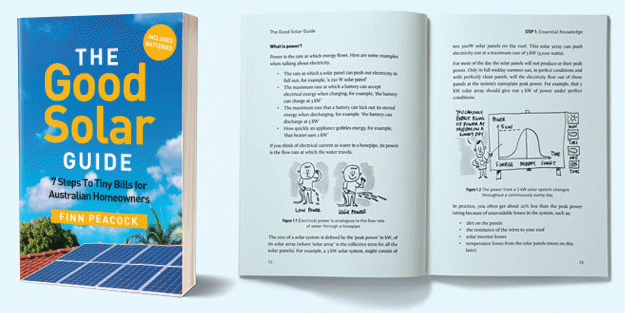
A cheery headline from a New South Wales state government news release published yesterday glossed over a bombshell contained within. But there is good news too (for some).
“NSW & Commonwealth double incentives for batteries,” declared the headline. I’ll get to what that’s actually about in a bit; but basically it’s only referring to a boost to Virtual Power Plant (VPP) incentives, not the state’s battery rebate.
In fact, around halfway down the news item was this (bolding mine):
“The increased Virtual Power Plant incentive will replace the NSW home battery installation incentive which has been doubled by the Commonwealth program.”
The NSW Government battery rebate (in practice and name an up-front discount) can continue to be claimed for home battery installations up until Monday 30 June 2025. But note the state government has confirmed the discount cannot be combined with the upcoming federal home battery rebate, which starts on Tuesday 1 July 2025.
The NSW Government had been seeking advice to make its incentive “stackable” with the federal subsidy and address a host of other issues. Obviously, that didn’t pan out.
While technically the NSW rebate can still be claimed until July 1, it now doesn’t make much sense to use it. Those considering buying a home battery are better off taking advantage of the federal battery rebate under the Cheaper Home Batteries Program.
According to the state government, the solar battery discount was a ‘huge success’, with more than 11,400 installations since it was launched in November 2024. But the reality on the ground is the incentive has been plagued with problems.
There’s understandably disappointment and some anger among both installers and solar battery buyers with this news. We’re informed some NSW installers had written in contract clauses they would take the hit if the rebate was withdrawn. Ouch.
As for buyers who have already signed on the dotted line but are now having second thoughts, see our recent article on rebate-related quotes and deposit refunds.
NSW VPP Payment Boost
Back to the better news, for some anyway.
When the NSW solar battery discount program originally kicked off, there were also two separate payments available if also joining an eligible Virtual Power Plant (VPP) program — one after joining and another could be claimed 3 years later.
Just briefly for those not familiar with what a VPP is, a Virtual Power Plant consists of Distributed Energy Resources (DERs) such as home batteries that are virtually co-ordinated by a central operator. This gives the operator control over when batteries are charged from and discharged to the grid. The nature and intensity of that activity depends on the program.
For the participant, there is usually an incentive for allowing their battery to be controlled by a third-party. You can compare various programs and what they offer on our VPP comparison table and learn about the pros and cons of Virtual Power Plants here.
The NSW VPP incentive has been increased to up to $1,500 from 1 July 2025 to encourage more folks to get on board with VPPs — and this will be a single payment. The incentive varies according to the size (energy storage capacity) of the battery. According to an example on the NSW Government explainer page; the new incentive amounts are estimated at:
- approximately $550 for a 10-kilowatt-hour ( kWh) battery
- approximately $1,500 for a 27- kWh battery.
… so in other words, around $55 per usable kWh (but that’s yet to be confirmed). Batteries will need to be between 2-28kWh capacity to receive the incentive.
And yes, the VPP incentive will be available to those who have installed a battery under the federal battery rebate program. Other existing eligible solar battery owners can also receive it, but they’ll need to work with an Accredited Certificate Supplier (ACP) to get signed up to a VPP.
On a related note, there was also a requirement to have 6+ years of warranty on the battery. According to SolarQuotes resident fact-checker Ronald Brakels, that requirement *may* have been removed as he didn’t see it currently mentioned on the state government’s VPP incentive explainer page.
Other Recent Battery Incentive Changes In Australia
The NSW Government’s announcement comes just a few days after the Western Australian government said its Residential Battery Scheme rebate will be slashed (but stackable with the federal scheme) and VPP participation will be mandatory. But on the positive side, the WA rebate will be made available to five times as many households — up to 100,000.
The Northern Territory’s government recently announced its up-to-$12,000 battery rebate has ended due to reaching the program’s funding cap of $6 million, and Victoria wound up its solar battery loans program in late May.
To stay up to date with what’s happening on the Australian home electrification rebates and subsidies scene, subscribe to the SolarQuotes weekly newsletter; delivered to your inbox each Tuesday.

 RSS - Posts
RSS - Posts



If I have read it correctly, if you install >28kwh of batteries, even if you connect to a VPP, you will NOT get any $1500 NSW VPP battery rebate. The federal battery rebate is for batteries up to 50kwh qualifying for a 30% rebate.
So it seems the NSW govt is effectively subsidising smaller battery installations only, at odds with the federal battery rebate subsidising people to install up to 50kwh.
Shame. A stacked discounts was the only way most batteries became economical, with an actual payback before they hit the end of their serviceable life. Just have to wait until electricity gets more expensive I guess.
We’ve calculated payback times for batteries after factoring in only the federal rebate here. For Sydney we estimate 8.3 years, well within a battery’s expected lifespan and also within a 10-year warranty period.
Your claim about how much time cost of capital adds is clearly wrong.
For Sydney you claim it would only add 1y
Yet the cost of capital at 6% and reduce savings by $423 a year, making payback time 8.3y. 2.7 years longer than your claimed 5.6y.
Given that the state rebate can’t be stacked your fed only calculation is $8500 cost, $1030 annual savings. Using a 6% cost of capital this now reduces annual savings by $510 to $520.
The payback period is now 16.3 years
For someone using an “average” amount of electricity. We use about half of that.
(Honestly, how do you people use so much electricity?}
You are not talking with the right installers then.
Our customers are well below the 10yrs ROI, and quite often closer to 6 years…
Can you show your calculations?
Simple napkin Maths:
16kWh battery used daily.
0.35c/kWh (can be a little less, can be a LOT more in some areas in peak hours)
365 days in a year
16*0.35*365= $2,044/year savings (that doesn’t take into account cost of electricity raising over time)
In most scenarios, we can easily install a Top3 battery of that size with an ROI below 6 years (after deducting the federal rebate, obviously).
Your “napkin maths” contains plenty of bad assumptions
1) 100% of the battery storage used each day
2) Your panels can add 16kWh per day beyond daily usage.
3) It never rains/very cloudy
4) You don’t lose 16kW+inefficiency of FIT per day
5) your $16k+ installed battery costs you around $1k in capital costs which you count as $0, when actually it halves your “savings”.
This so called Labor Government of NSW is a real disappointment.
Huge slashes to Education and now renewables.
Not just that it is renewables. For the remaining rebate to require VPP participation is shockingly right wing. I could see Liberal doing it with a smirk, but a Labor government should hang their head in shame. Wholesale participation does the same thing for peak demand and decarbonisation, but it is not included as an option. Only VPPs, handing more of the profits from the battery to corporations instead of helping more with payback with better direct wholesale market returns.
An on price for all, bundling home batteries into more gentailer bidding control is also only going to help perpetuate peaks.
You can still participate in the wholesale market with Amber as long as you have a battery. And given the rebate was only ever related to batteries that doesn’t seem all that unfair. https://help.amber.com.au/hc/en-us/articles/31159992778893-New-South-Wales-Battery-Rebates-PDRS
Those with the risk appetite and enthusiasm to play the wholesale energy markets would not be limiting themselves to 28kw of batteries. they would want to go all in for a 50kw battery system to maximise economies of scale. Unfortunately, it’s these very people who actualy do want to run a small scale power plant that the NSW government has thrown under the bus by limiting the VPP rebate to 28kw batteries only and giving $0 to anyone who goes for a bigger battery than that.
Last year I signed up to Amber.
I have a 10kW Solar system and 3 Tesla PW2 batteries.
I was with them for 2 months.
During this time they tried to fully recharge my PW2 batteries at around 1400hrs even though my Solar was efficient to achieve this.
To stop the charging I went off grid till around 1600hrs and batteries full, would then go back on grid till next day.
I complained repeatedly to them asking them to make my charging my choice.
After I changed back to my previous supier they finally responded a d said I could choose a different plan.
Sadly the aim of the plans was opaque, so did not know of this possibility.
Happy That I now am b ack to self consumption and low feed in as the VPP experience was not good
Is localvolts an option for you?
I haven’t read much reviews but on paper it seems very interesting.
Just had a look , I think i’ll stay with the low feed in tariff.
Just as aside we get up to 4 days of rain/cloud till batteries flat so self consumption wins so far
Oh well, at least the NSW rebate had a fair run. The WA election promise was basically reneged on almost immediately.
11,400 in 6 months is a drop in the ocean.
And with the paperwork nightmare that was associated with it, no installer in NSW is going to cry for it.
Hopefully the new battery rebate is more realistic. That we will know from July 1st…
No panel deal or battery rebate for tiny homes wanting be off-grid.
Where’s the Federal or State help for people unable to get into the housing market.
Politicians are all smoke and mirrors
You can get the battery rebate if you are off grid…
The NSW government are bloody disappointing, reneging on a energy policy that their party obviously believed in, and their voters voted for.
They had a real opportunity to assist in making battery installations by private equity an acceptable ROI for the private investor.
It was a win…win situation to get private equity and governments to invest into energy infrastructure.
The ROI is nowhere near acceptable now, even using the NSW VPP max rebate of $1500.
Especially if I’m forced to go in the VPP to get this NSW rebate, where I’ll have little control on how the battery is used, higher degradation on the battery.
And we’d probably get lower ROI on a VPP, because we’d be feeding the grid more instead of offsetting my own energy costs.
We’d be better off investing $15k in the stock market
Hi CA,
Problem with the stockmarket is that it’s often pretty counterproductive to anything tangible, like a liveable climate, breathable air, drinkable water.
We’ll go down as the first species to go extinct because it wasn’t economically viable.
Risible
Compulsory VPPs are outrageous. None of them offer an option to demand a return on a cycled kWh that is greater or equal to the levelised cost of storage (LCoS) for each warranted kWh you have paid for. So you are signing to effectively lose money on your investment. They are unpopular for good reason.
VPP readiness, as per the federal scheme is different. It means you can instead elect to go on a wholesale tariff like Amber (who offer VPP-like optimised automation if you want). With that, you have the same wider benefit to the grid by exporting into the highest demand (as signalled by price) and sometime importing when utility renewables are being curtailed (negative wholesale prices) – at least in NSW, with a more peaky market.
So the choice the NSW government is essentially making is that they are prepared to help the transition (for votes or a conscience), but insisting that legacy gentailers or other corporate interests still get to wet their beaks along the way.
Typical NSW govt with lack of detail and spinning like a top. I guess they don’t know what’s going on also.
Question. If I install a battery and claim the (up to) $1500 rebate, how long before I can opt out?
I opted out of my VPP after 6 months. Could have done it earlier.
I just had my 24kw battery installed on Friday 6/6 but left switched off and not connected until after July. Just had phone call from my solar installer (Penrith Solar) to inform me that the state government had scrapped their battery rebate with no warning leaving me with a bill for over $4000 that I hadn’t budgeted for. Poor bloke had to call so many customers who had done pre-installs and tell them the bad news. 🤬🤬🤬
Just when we thought the NSW Govt couldn’t make a bigger c@ckup they ask the solar industry to hold their beer…
Same thing has just happened to me with a 19.8 kWh battery. Owe another $3300. It is outrageous that they led installers to believe that the two schemes would still apply.
So many installers will have been making these calls and no doubt facing a lot of frustration and anger.
Could a class action work?